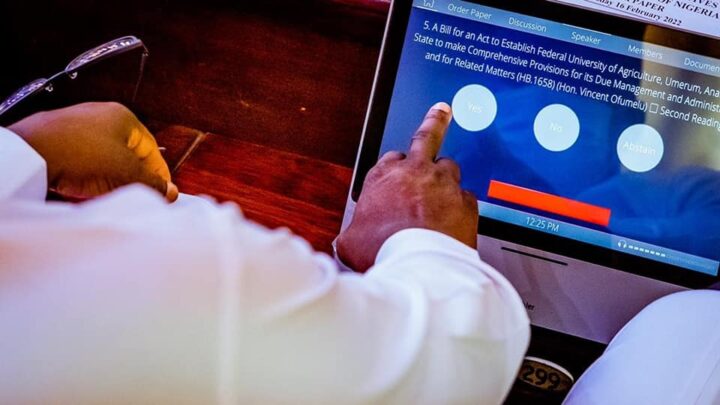The house of representatives, on Wednesday, conducted its legislative business using electronic voting.
The lawmakers used the e-voting system to vote for and against bills and motions on the floor of the parliament.
The development comes years after Femi Gbajabiamila, speaker of the house, unveiled the e-voting/e-chamber register for the lawmakers.
At plenary session on Wednesday, Femi Gbajabiamila, speaker of the house, said the lower legislative chamber will commence using e-voting rather than the regular voice voting system.
Advertisement
Order 11, rule 7 of the house of representatives provides that a member shall vote according to his/her voice, signing of the register in a decision or through electronic voting installed in the house.
TheCable understands that e-voting is part of the legislative agenda of the house of representatives, but the system has not been used since the unveiling of the e-voting/e-chamber attendance register in July 2019, following the inauguration of the ninth house of assembly.
“This is one of the things we promised to do in the ninth assembly,” Gbajabiamila had said while inaugurating the new system.
Advertisement
“I am glad we have been able to deliver that within a year. We promised e-voting. Seamlessly, the chamber is now more or less paperless.
“In front of you on your seats, you have little panels that we installed. This is in keeping with some of the reforms we have talked about that Nigerians will see. By tomorrow, I expect it to be fully operational. The whole system is based on the fact that we will soon be having e-voting in this chamber.
“Now, this will not be applicable to all motions and bills, because we have several of them. For those that we consider important, and of significance, we will be adopting the e-voting system. We don’t need your voting card. You only need to press a button and it tells you who voted, which side they voted for.”
The voice-vote technique is the common way of voting in the national assembly, but it is sometimes fraught with controversies.
Advertisement
In 2021, while the legislators were debating the clause-by-clause consideration of the electoral act amendment bill, Idris Wase, deputy speaker of the house, ruled against a majority voice vote.
A motion on a clause of the electoral bill was put to a voice vote, and the “ayes” were louder than the “nays”, but Wase had ruled in favour of the “nays”. There are several other instances of such situations.
Speaking on Wednesday during the test-run of the e-voting system, Gbjabiamila said there is a need for constituents to be aware of the “voting pattern” of the lawmakers, ahead of the consideration of the bills on constitution amendment.
“We need to know the voting pattern of members. And the constitutional amendment is coming up for voting in a week or two and we will need the required numbers. It is the only way we can vote on the constitutional amendment,” he said.
Advertisement
“Every vote must count because it is a serious business. Our constituents must know how we voted on issues and this will have to be open to the public.”
Constitutional amendment bills require a certain number of legislators to vote on the clauses and a two-thirds majority to pass.
Advertisement
Section 9(2) of the constitution states that “an Act of the National Assembly for the alteration of this Constitution, not being an Act to which section 8 of this Constitution applies, shall not be passed in either House of the National Assembly unless the proposal is supported by the votes of not less than two-thirds majority of all the members of that House and approved by resolution of the Houses of Assembly of not less than two-thirds of all the States”.
Meanwhile, the senate had, in 2017, used the e-voting system during a clause-by-clause debate on consideration of amendments to the 1999 constitution.
Advertisement
Add a comment






